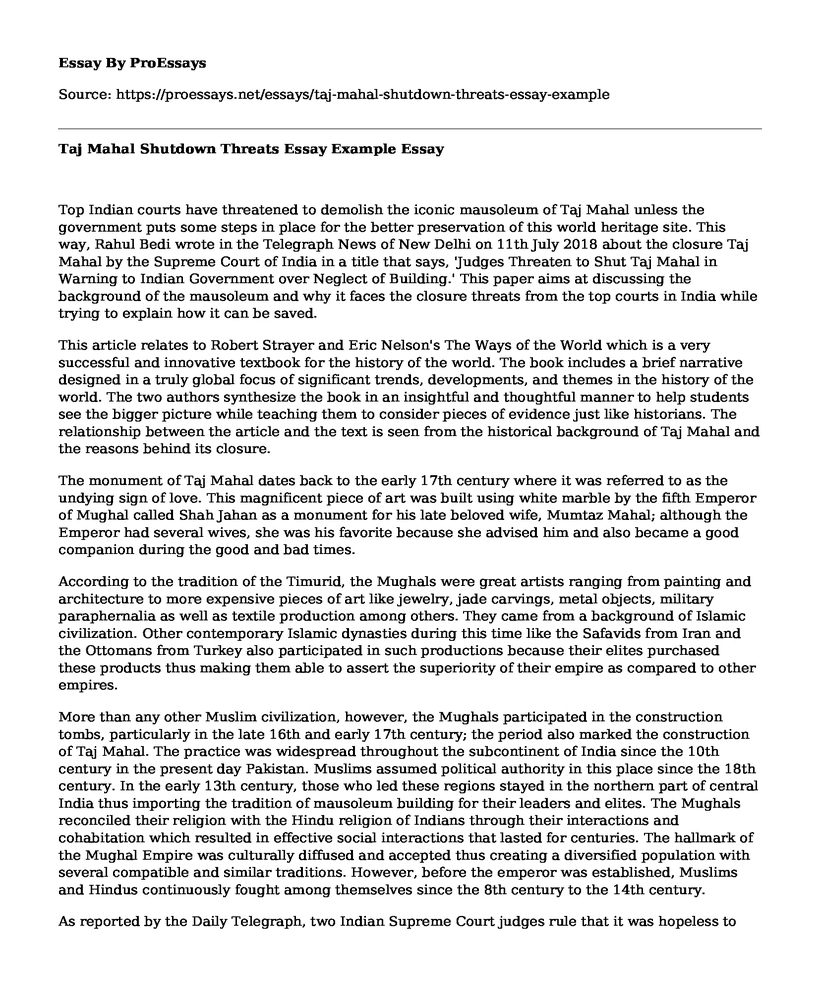Top Indian courts have threatened to demolish the iconic mausoleum of Taj Mahal unless the government puts some steps in place for the better preservation of this world heritage site. This way, Rahul Bedi wrote in the Telegraph News of New Delhi on 11th July 2018 about the closure Taj Mahal by the Supreme Court of India in a title that says, 'Judges Threaten to Shut Taj Mahal in Warning to Indian Government over Neglect of Building.' This paper aims at discussing the background of the mausoleum and why it faces the closure threats from the top courts in India while trying to explain how it can be saved.
This article relates to Robert Strayer and Eric Nelson's The Ways of the World which is a very successful and innovative textbook for the history of the world. The book includes a brief narrative designed in a truly global focus of significant trends, developments, and themes in the history of the world. The two authors synthesize the book in an insightful and thoughtful manner to help students see the bigger picture while teaching them to consider pieces of evidence just like historians. The relationship between the article and the text is seen from the historical background of Taj Mahal and the reasons behind its closure.
The monument of Taj Mahal dates back to the early 17th century where it was referred to as the undying sign of love. This magnificent piece of art was built using white marble by the fifth Emperor of Mughal called Shah Jahan as a monument for his late beloved wife, Mumtaz Mahal; although the Emperor had several wives, she was his favorite because she advised him and also became a good companion during the good and bad times.
According to the tradition of the Timurid, the Mughals were great artists ranging from painting and architecture to more expensive pieces of art like jewelry, jade carvings, metal objects, military paraphernalia as well as textile production among others. They came from a background of Islamic civilization. Other contemporary Islamic dynasties during this time like the Safavids from Iran and the Ottomans from Turkey also participated in such productions because their elites purchased these products thus making them able to assert the superiority of their empire as compared to other empires.
More than any other Muslim civilization, however, the Mughals participated in the construction tombs, particularly in the late 16th and early 17th century; the period also marked the construction of Taj Mahal. The practice was widespread throughout the subcontinent of India since the 10th century in the present day Pakistan. Muslims assumed political authority in this place since the 18th century. In the early 13th century, those who led these regions stayed in the northern part of central India thus importing the tradition of mausoleum building for their leaders and elites. The Mughals reconciled their religion with the Hindu religion of Indians through their interactions and cohabitation which resulted in effective social interactions that lasted for centuries. The hallmark of the Mughal Empire was culturally diffused and accepted thus creating a diversified population with several compatible and similar traditions. However, before the emperor was established, Muslims and Hindus continuously fought among themselves since the 8th century to the 14th century.
As reported by the Daily Telegraph, two Indian Supreme Court judges rule that it was hopeless to protect the monument from environmental degradation while castigating the authorities for being concerned with its maintenance. The government failed to apply the protection measures outlined in the recent parliamentary report, hence resulting in substantial revenue losses that were above calculations. Therefore, the two judges suggested the monument to be shut down, demolished or done away with, depending on the decision of the government.
The judges criticized the government for not taking good care of the monument; despite being more beautiful than Eiffel Tower which resembles a TV tower, the judges added that Taj Mahal received much lower visitors thus prompting foreign exchange problems. The white marble that once gleamed on the mausoleum had been discolored due to the environmental pollution of Agra in Uttar Pradesh. The court noted that the government allowed expansion of industries towards the monument, making the problem even worse. Additionally, the monument got infested by several tiny insects breeding in the rubbish of River Yamuna. This led the marble to corrode and stain further due to the excrement of the insects.
Conclusion
If Taj Mahal's symbolism could be harnessed, a cleaner river and air, as well as better living conditions, would be achieved. However, most of the flaws of the monument do not detract from its overall effect. Besides, the yellowing and pocking make it even more beautiful just like the flaws in an oriented handmade carpet makes the power more aesthetic. It is also comforting to stand before the Taj Mahal because it makes one appreciate its wonder. The Taj Mahal is a single masterpiece that is likely to last for many years; however, it cannot last forever without our best efforts.
Cite this page
Taj Mahal Shutdown Threats Essay Example. (2022, Oct 20). Retrieved from https://proessays.net/essays/taj-mahal-shutdown-threats-essay-example
If you are the original author of this essay and no longer wish to have it published on the ProEssays website, please click below to request its removal:
- Paper Example on Effects of Social Media Marketing and E-Store on Luxury Brand Exclusivity
- Glory 1989 Film Analysis Essay
- Research Paper on Rock Music in the 1960s
- The Impact of Social Media on Depression Annotated Bibliography Paper Example
- Essay Sample on Social Media and Ourselves: Networked Publics
- Black Mirror Episode 1 Season 5
- Songs Reflect, Depict and Impact Los Angeles - Essay Sample







